
With the new generation of its OSTAR™ Projection Power LEDs, ams OSRAM sets innovative standards in LED technology for compact projection systems — and head-up displays (HUDs) in the future as well. The company is planning to test these products with the U.S. Automotive Qualification Standard AEC-Q102. Once the test is completed, the LEDs will also be suitable for automotive projection applications. The LEDs not only enable a compact design and precise etendue matching with DMD (Digital Micromirror Device) imagers but also increase projector-level brightness by 10–15 %.
Two applications, one LED: Projection and Automotive
Projector manufacturers today face the challenge of developing ever brighter, smaller, and more efficient devices. The new OSRAM OSTAR™ Projection Power LEDs meet these requirements with brilliance: delivering up to 880 lumens in a compact 6.8 × 7.6 mm package, they are simply ideal for mini and pico projectors. Thanks to optimized etendue matching for 0.3x, 0.4x, and 0.6x inch DMD (Digital Micromirror Device) systems, maximum light output is achieved. Automotive manufacturers could also greatly benefit from this technology: in modern head-up displays, the high brightness and color fidelity of the LEDs ensure a clear, high-contrast display — even in direct sunlight. The compact design would allow seamless integration into space-constrained vehicle cockpits.
“With their superior energy efficiency and long lifetime, the new OSTAR™ LEDs also contribute to sustainability — an increasingly important factor for our customers. At the same time, they help significantly to reduce maintenance efforts and operating costs over the entire product lifetime”, emphasizes Vicknes Ratha Krishnan, Product Manager at ams OSRAM.
Technological solutions for the highest demands
The OSTAR™ Projection Power LEDs impress with precise etendue matching, enabling optimal light coupling in DMD systems. This ensures maximum efficiency and brightness in projection. Their ultra-compact design with high power density — up to 6.6 A/mm² for the blue and green variants — enables their use in particularly space-saving devices without compromising light output. Thanks to their support of four-channel systems (Amber, Converted Green, Blue, Deep Blue), the LEDs offer excellent color rendering and high design flexibility. The innovative chip technology with its isolated structure enables particularly high current density and ensures stable performance even under demanding conditions. Integration into existing systems is significantly simplified by the serial chip connection with low forward voltage. This not only reduces the complexity of the driver electronics but also the overall cost. In addition, the copper metal-core PCB improves thermal management and facilitates assembly thanks to SMT (Surface Mount Technology) compatibility. The LEDs impress with their high reliability and long service life — a clear advantage over lamp-based light sources, especially in long-life applications such as industrial projection — or automotive as well.
(Photo credit: ams OSRAM)
TrendForce 2025 Global Automotive LED Market- Lighting and Display Product Trend
Release Date:
1. PDF (196 Pages)- 30 June 2025
2. EXCEL- 30 June 2025 and 31 December 2025
Languages: Traditional Chinese / English
|
If you would like to know more details , please contact:
|












